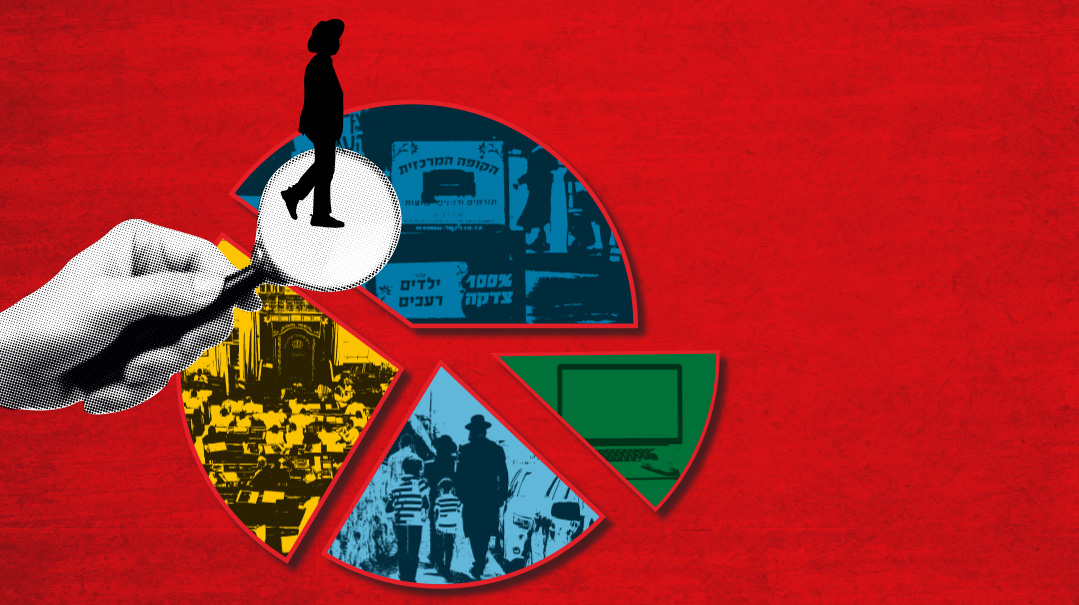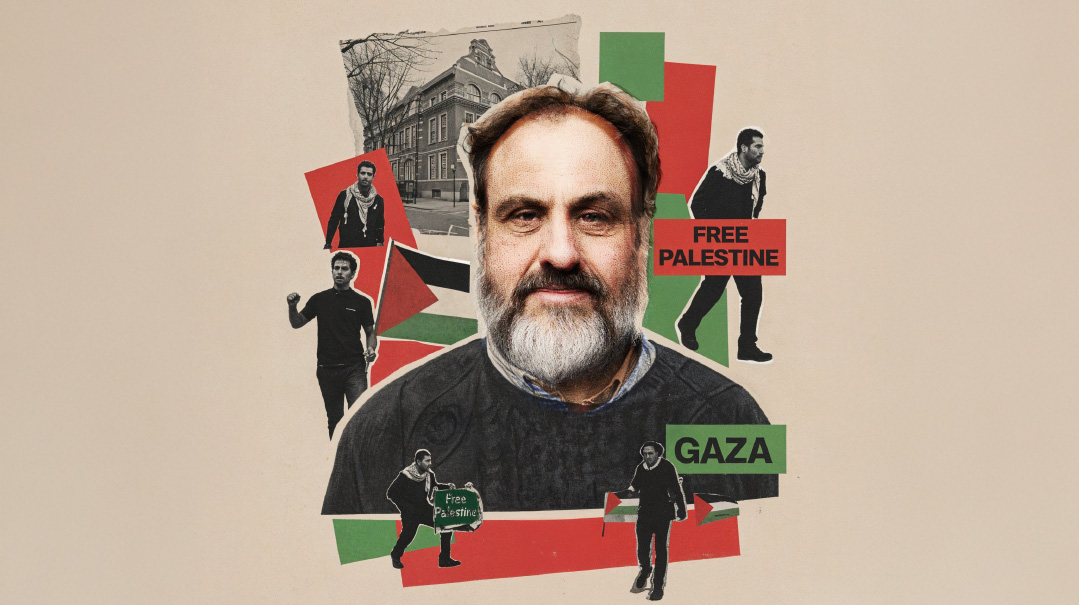Biggest Piece of the Pie?
| August 6, 2024Are studies about the chareidi sector objectively research-based or primarily a perpetuation of false claims with an agenda?

Photos: Flash90
For years, the Israeli public has been fed one study after another exposing once and for all how the chareidi sector is stiffing the treasury and extorting far more than their share in government grants and services. Yet are these studies objectively research-based or are they primarily a perpetuation of false claims with an agenda?
IF you’re a consumer of Israeli media, you’ve surely heard the claims that the chareidi community in Eretz Yisrael benefits disproportionately from government funding and leeches off the treasury. Those claims are given legitimacy by graphs and statistics, policy papers from prestigious research groups, and even quotes from senior officials in the Finance Ministry.
Claims such as, “Chareidi students receive NIS 1,500 more a month than their secular counterparts;” “Chareidi gemachs are involved in money laundering and should be banned;” or “Only 30 percent of chareidi bochurim actually attend yeshivah,” are just some of the tropes used to delegitimize the chareidi community and create a national consensus that members of this demographic are parasites draining an otherwise healthy and stable economy.
But even when these claims don’t translate directly into policy, they contribute to the deepening divide in Israeli society. The Israeli public is fed a stream of statistics purporting to expose the chareidi fraud, yet how legitimate are these studies? Are they based on research or just the perpetuation of false claims? And, is there an understanding of the priorities and worldview of the larger chareidi community that is a fundamental aspect of a legitimate study?
In order to provide accurate, reliable, and in-context data on chareidi society, one research group has risen to the challenge: The Wahl Data Center, an initiative of the Haredi Institute for Public Affairs, was created to provide relevant and accurate data on this segment of Orthodox society, in order for decision-makers to have reliable and precise data before formulating policy — because without accurate data, policies don’t always address real needs.
Prior to the Data Center’s involvement in this demographic, policy decisions relied solely on data from the Central Bureau of Statistics and the interpretations researchers derived from them. While the CBS provides significant data on Israeli society, it is often incomplete and limited in scope. But by using an algorithm developed by data scientists at the Haredi Institute for Public Affairs, the data center has been able to achieve an extremely high detection rate of trends in the ultra-Orthodox population, including demography, education, employment, higher education, housing, consumerism, and digitization.
The effectiveness of this approach was underscored by Professor Yaron Felus, the head of the CBS, at the recent launch event for the Data Center.
“The CBS does not have the knowledge and capability to provide detailed contextual analysis, especially regarding minority populations and each of their sub-demographics,” Felus admitted. “By filling this void, the Data Center is critically important, and a welcome addition to the public policy sphere.”
“One cannot overstate the paramount importance of accurate and reliable data as the cornerstone of effective policy formulation,” explains Dr. Shai Stern, deputy chairman of the Haredi Institute. “In a nation as diverse as ours, where unique populations like the ultra-Orthodox community thrive with their distinct lifestyles, a profound understanding of demographic data empowers decision-makers to craft informed policies that honor and address the singular characteristics of these groups. The new data center offers an unprecedented opportunity to challenge long-held misconceptions deeply entrenched in Israeli society, paving the way for a more nuanced and overdue discourse on critical issues.”
The following is an examination of some previous studies and how they’ve been used to vilify the chareidi demographic to an unwitting Israeli public.
Case study
The State of Israel vs. Gemachim
The claim
Chareidi gemachim are part of a sophisticated money-laundering scheme serving wealthy Jews abroad
Research
Taub Institute
The result
The drafting of a “Gemach Law” that could have led to their closure. The bill was amended after extensive lobbying
“Rich Jews from Abroad and an Unbelievable M.O.: How Chareidi Gemachim Launder Money,” read The Marker’s sensational headline. The author of the piece, the paper’s associate editor Meirav Arlosoroff, described in detail the alleged criminal practices of the chareidi charity machine:
“The money-laundering operations of the gemachim, it turns out, are incredibly complex,” she wrote in a 2016 column. “It includes donations from wealthy Jews divided between numerous gemachim to conceal the total amount. In reality, the donation is a loan, which the gemachim loan out in turn.... After the loan is collected, the money returns to the United States, again split into small amounts in the form of donations to American charities. Charities return the money to the original money launderer, for example, by hiring them for services at an inflated price. The mechanism involves dozens of bodies, and sometimes hundreds of intermediaries.”
It’s a fantastical story, by all accounts: An entire network of chareidi agents helping criminals evade taxes and launder illegal money under the guise of charity. The bottom line? Gemachim should be subject to the same oversight and regulations as financial institutions that loan money for profit, and be under strict scrutiny because of a suspicion of money laundering. Among other things, the managers of gemachim — most of whom are tireless, dedicated volunteers or earn a minimal service fee, a concept difficult to understand in a secular mindset that expects financial remuneration from all services — would be required to have formal certification in order to continue their altruistic work. In practice, this would force most gemach managers to close their doors.
The report was based on a study by the Taub Institute, although there wasn’t a single known case in which a gemach manager was complicit in a crime. Furthermore, gemachim couldn’t have abetted money laundering even had they wanted to. That would only have been possible had the gemachim been recognized for tax purposes, and few gemachim are registered as such. Monies from most gemachim are generated by private deposits from people who prefer their extra cash be used for a mitzvah. In addition, the claim relied on a theory that 80 percent of gemach monies are returned to the US in the form of donations. But there are no figures that indicate the large-scale movement of charitable funds from Israel to the US.
Another claim made by the study is that the percentage of bad debts for gemachim is between ten and 20 percent. In practice, researcher David Godinger of the Hebrew University found that the share of bad debts in gemachim is just two percent (compared to three percent in banks) and that most of these debts are ultimately collected from guarantors, shrinking the rate of bad loans to 0.5 percent.
In practice, thanks largely to a team of researchers from the Hareidi Institute for Public Affairs led by Professor Yoram Margaliot of Tel Aviv University, the bill was amended to match the reality. Gemachim would be subjected to oversight and regulation in a way that takes into consideration the special charitable role of gemach managers and allows them to continue to lend money without interest, as has always been the case.
Case study
It’s worth being chareidi for the tax benefits alone
The claim
The average chareidi costs the state thousands of shekels more than their secular counterpart
Research
Dr. Michael Sarel, former chief economist at the Ministry of Finance and director of Kohelet Economic Forum (the study was not a Kohelet position paper)
The result
Another layer of public hostility against the chareidi community
How much does a chareidi family cost the State of Israel? If you ask the average Israeli, the answer will likely be something along the lines of: I don’t know, a lot, a ton.
The claim is often heard in Israeli public discourse that the chareidim don’t pay taxes while living off Israeli taxpayer money, but the point is generally made in the abstract, without hard data. Yet a recently released study attempted to find the difference between how much the average chareidi family pays in taxes and how much it receives, in the form of, for example, property tax discounts, stipends, funding for education, and so on.
Finally, the secular taxpayer could rightly feel cheated: The study found a difference of NIS 10,000 between the average secular household and its chareidi counterpart. While a chareidi household receives NIS 4,000 more from the state than it pays in taxes, both directly (in the form of child subsidies, birth grants, or income support) and indirectly (educational funding, health insurance, and the like), the average secular household shelled out NIS 6,000 more than the value of government services received in return. In other words, the average secular person was financing the chareidi lifestyle.
Of course, as in any macroeconomic study, the study couldn’t account for all tax money and how it’s spent. For example, the study didn’t address culture and sports funding, an area in which the chareidi community is massively discriminated against, with the few events for the chareidi community over the past few years facing legal challenges on grounds of gender segregation.
The very assumption that the ratio of taxes paid to benefits received should be measured at the household level is fundamentally problematic. While taxes are levied at the household level, state benefits are awarded on an individual basis. Education, health, and other budgets are calculated per capita, not by family. So a family with ten children will receive more funding than a family with two, although funding for each child is the same. That’s why the gap seems so pronounced, especially in the area of education, where the average secular family receives only NIS 1,677 from the state, while a chareidi family gets an average of NIS 4,158. Furthermore, even this apparent discrepancy is probably inaccurate. In reality, the state’s expenditures for the education of a chareidi male are between one quarter and one fifth of the secular student’s, given classroom size criteria, educational benefits, and all the extra-curricular benefits. A similar discrepancy exists for girls, though it’s a bit lower.
As you might expect, the study was pounced on by the secular Israeli press, yet one of the main problems with the study was not the data itself, but its lack of context, and that was reflected in comparative income levels. The average chareidi household earns 40 percent less than the average secular one, despite having many more children. That means it pays less income tax, and might be eligible for a tax credit. That’s how it works with low-income earners all over the world.
Case study
How the yeshivah world closed down
The claim
Budget cuts reduced the number of yeshivah students from abroad by 90 percent
Research
The Jerusalem Institute for Policy Research and the Israel Democracy Institute
The result
The study was refuted and proved to be baseless
According to a 2016 annual report on chareidi society in Israel, jointly published by the Jerusalem Institute for Policy Research and the Israel Democracy Institute, during the period between 2012 and 2013, the normally packed Beis Yeshaya beis medrash of the Mir yeshivah in Jerusalem’s Beis Yisrael neighborhood was deserted, save for a few maintenance workers and a handful of dedicated holdouts. In the Beis Shalom beis medrash, attendance of Rav Asher Arielli’s daily shiur was sparse, and on the other side of the street, the smaller Shlamei Simchah beis medrash was nearly empty. And despite it being the height of the winter zeman, the near total absence of the chutznik students in one of the most popular yeshivos for students from abroad was notable. And it wasn’t just the Mir — in batei medrash all over Jerusalem and beyond, the benches were empty, with a whopping 90 percent drop in the number of yeshivah students from abroad.
At least that’s how it looked through research glasses. The study went on to describe — based on its statistical research — the veritable exodus from the halls of Torah: First, during those two years, the state granted 20,000 kollel exemptions from military service, which meant a quick exit from the beis medrash to the work force. Second, the state cut support for yeshivah students and avreichim who don’t serve in the army by 50 percent, which meant most of them left yeshivah, and with canceled support for students from abroad, up to 90 percent of bochurim from chutz l’Aretz stayed home.
How did we never catch on to it? Now it’s so obvious that yeshivos are simply refugee camps for draft dodgers and schnorrers. As soon as conscription worries were lifted on one hand, and the budgetary faucet was shut off on the other, the bubble burst.
The theory continues: In 2015, the chareidim reentered the coalition, the Netanyahu government renewed the budgets for yeshivah students, and that year the number of students from overseas jumped by over seven hundred percent.
Well, so much for the theory. In reality, explains Eli Paley, chair of the Hareidi Institute for Public Affairs, the study relied on figures reported to the Education Ministry for subsidy purposes. So as soon as funding was suspended for students from abroad, yeshivos had no interest in filing the paperwork to report them. The yeshivos remained as packed as before. Furthermore, there are an additional 2,500 students from yeshivos such as Brisk, Praeger’s, and others, that don’t take government funding at all and never register with the Education Ministry.
Case study
Yesh Atid added 60,000 chareidim to the work force
The claim
The policies of former Finance Minister Yair Lapid and his deputy Mickey Levy led 60,000 chareidim to leave the beis medrash and join the work force
Research
MK Mickey Levy, Yesh Atid
The result
An embarrassing retraction
“When Lapid and I were in the Treasury and we stopped the funding, 60,000 people left yeshivah for the workforce”
“I tell you from experience, when Lapid and I were in the Treasury and we stopped the funding, 60,000 people left yeshivah for the workforce because they couldn’t make a living,” MK Mickey Levy said in an interview on Radio 103FM last month.
An impressive statistic, by all accounts. But was it true?
According to Dr. Eitan Regev of the Hareidi Institute for Public Affairs, during Yair Lapid’s first year as finance minister between 2011 and 2012, there were about 54,000 chareidi men in the labor market — almost the same figure as the year before, when the finance minister was MK Yuval Steinitz of the Likud. In 2014, his second year at the Ministry of Finance, there was a jump of about 7,000, raising the number to about 61,000.
The economic newspaper Globes contacted Lapid for his response, who admitted: “We apologize. We did preside over an increase, but the number was indeed much smaller. Mickey confused the number of yeshivah students who went out to work with the overall number of working chareidim.”
Case study
Most avreichim aren’t actually attending yeshivah
Claim
Only 30 percent of enrolled yeshivah students are actually learning
Research
Channel 12, relying on a study by the National Economic Council in the Prime Minister’s Office
The result
The IDF adopted the report’s conclusions, and the Israeli media accepted the numbers as fact
Earlier this month, Channel 12 aired a three-part documentary series by Gilad Shalmor covering the chareidi yeshivah world. Shalmor visited the Ohr Yisrael yeshivah in Petach Tikvah for the first segment, covering bochurim who are learning, while the second segment was devoted to bochurim who aren’t learning in yeshivah but don’t enlist either.
In the report, Channel 12 revealed a shocking statistic: “Of 67,000 chareidim registered in yeshivah, only 30 percent study full time.”
And what do the rest do? According to the report, they’re divided into three groups: those who study in “lenient” yeshivos, those who split their time between working and learning, and those who neither work nor learn.
Yet if you walk into Yeshivas Chevron in Jerusalem, you’ll see a well-packed hall that can hold 2,000 bochurim. At the Mir, approximately 10,000 meals are prepared daily. And that’s just two of hundreds of yeshivos whose batei medrash are full, not even counting the numerous smaller yeshivos and kollelim.
Calcalist reporter Yuval Sadeh, who echoed the data, referred me to an interview he conducted with Maj. Gen. Eliezer Shkedi: “A study was conducted in 2019 by the National Economic Council in the Prime Minister’s Office, which looked at chareidim aged 25-34 and found that 13 percent of them don’t learn or work, 39 percent only work, 19 percent learn and work, and 29 percent learn full time. You look at that, you see that there’s enormous potential here, both in Ben-Gurion’s philosophy and in Rav Shach’s philosophy.”
Shkedi is referring to the fact that both Ben-Gurion and Rav Shach talked of how only bochurim who learn full time deserve an exemption. Judging by this, 70 percent of the exemptions received are unjustified, even, apparently, according to Rav Shach.
Without entering a hashkafic debate on Rav Shach’s views regarding the draft, let’s just focus on the numbers: The study was done on bochurim aged 25 to 34. Even if we assume that it’s accurate, and ignore the fact that many of those employed are working in Torah-related fields such as education, there’s a much more basic issue: These figures have nothing to do with yeshivah bochurim.
Yeshivos, as we all know, primarily accommodate unmarried young men under the age of 24. Most of the chareidim involved in the study weren’t yeshivah bochurim at all, but rather kollel avreichim.
In fact, the Tal Law in its last iteration, before it was struck down by the High Court, allowed married avreichim over the age of 22 to work, as long as they learned for the minimum number of hours necessary to be recognized by law for “Toraso umanuso (his Torah is his occupation).” This remedied the previous situation in which an avreich in his 30s, with a houseful of children, who learned eight hours a day, was legally prevented from earning a living in his spare time. This hurt everyone, the families of avreichim, the chareidi community, and the Israeli economy as well.
In 2019, the Tal Law was no longer in effect, but most avreichim of that age group had already received a blanket exemption as part of the policy in force at the time — so none of them broke the law or “dodged the draft,” even according to Ben-Gurion. Still, the myth of the 70 percent isn’t being put to rest so fast.
(Originally featured in Mishpacha, Issue 1023)
Oops! We could not locate your form.







